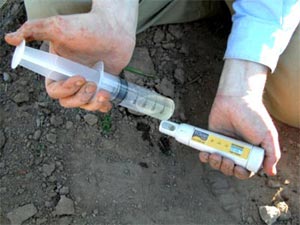|
|
||
|
|
Electrical conductivity or EC is the easiest and single most useful measurement to make on a soil water sample (see picture). EC is a measurement of how much electric current can pass through a water sample. Fresh water has a low EC because it does not contain many salts; the more salt the water contains the higher the EC.  EC is a quick way to measure the total salts in the soil, both 'good' salts for the irrigator like nitrate and potassium and 'bad' salts like sodium and chloride. Many people find salt or EC measurement complicated because there are so many different ways of measuring how much salt is in a water sample. A common measurement for salt is in concentration units or mg/L (mass of salt per litre of water) or parts per million (ppm ≠ grams of salt per million grams of water). We will always use units of conductivity (measured in the unit 'deciSiemens per meter' or dS/m). The reason is that conductivity is the quickest and cheapest thing to measure. Conductivity readings (dS/m) can be converted to concentration units (mg/L). Irrigation water should have an EC of less than 0.8 dS/m (500 mg/L). Water with an EC of between 0.8 and 2.3 dS/m (500-1500 ppm) is considered marginal for irrigation. The water will not taste salty, but salt levels will build up quickly in the soil and need to be managed carefully. Water with an EC greater than 2.3 dS/m (1500 mg/L) is generally not suitable for irrigation. Soil water has a higher EC than irrigation water because of dissolved nutrients. In addition the salts in the irrigation water tend to accumulate in the soil. Salt concentrates in the soil water if there is no downwards leaching, because plants transpire fresh water and leave the sodium and chloride behind in the root zone. Crops that are sensitive to salt, like beans, clover or plums may experience reduced yield when the EC of the soil water increases above 1 to 1.5 dS/m. Crops more tolerant to salt, like squash or rye grass, can tolerate EC levels between 3 and 6 dS/m without much harm. Crops tolerant to salt, like cotton and barley, can withstand EC levels over 7 dS/m. For comparison, sea water has an EC of 54 dS/m. The above EC limits for sensitive and tolerant crops are a guide only, because the type of salt is also important. We have observed EC readings well above the limits for the respective crops listed above, but these high readings were mostly due to soil nutrients dissolved in the water. This will be discussed more on the next page. If slightly saline water is used for irrigation, or deficit irrigation practices are used, then it is essential to monitor the build up of salt in the root zone and apply leaching fractions when necessary. |
|